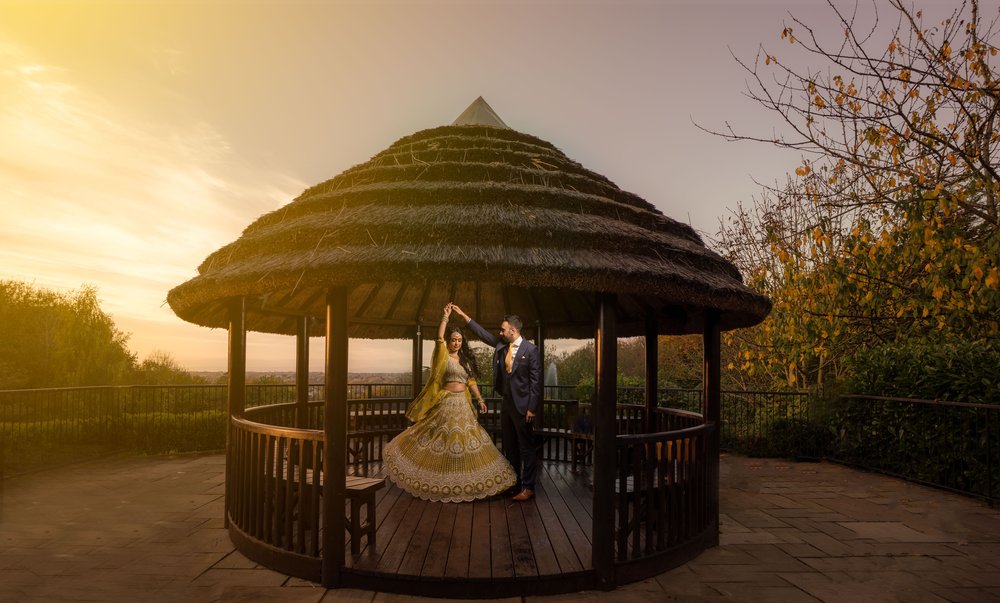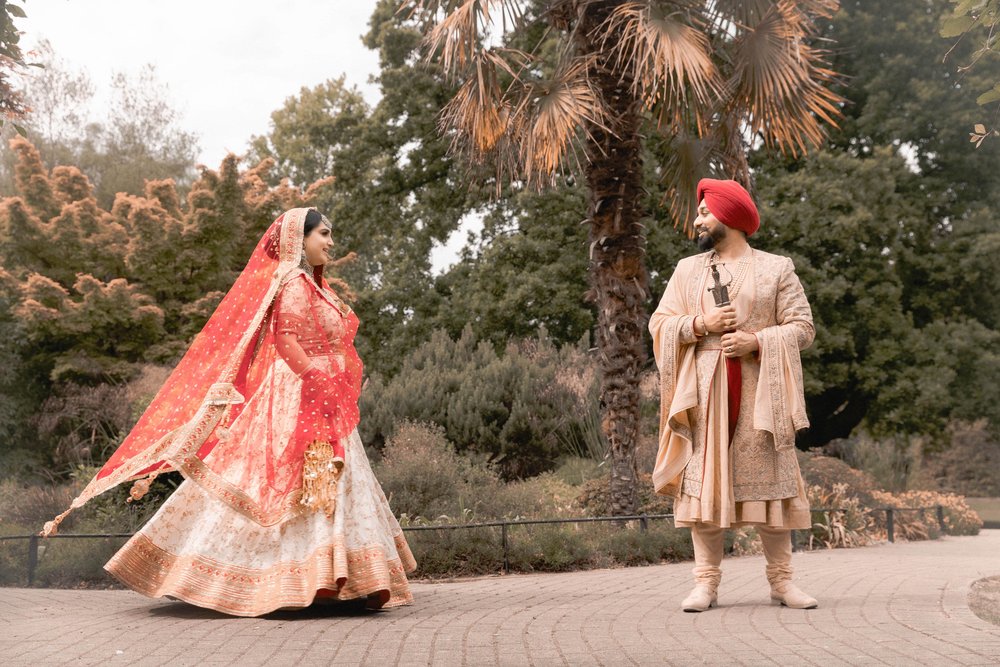
Sikh Wedding Photography
Hi, I’m Harpreet, a multi-award-winning Sikh wedding photographer, and I provide exceptional Sikh Wedding Photography. Sikh weddings are energetic, large, colourful, and lavish, with lots going on.
I have extensive experience capturing Sikh Weddings, so you can be confident you will receive fantastic wedding photographs of your celebrations!
Sikh Weddings – The Roka & Thaka Ceremonies
The Roka (meaning “To Stop” searching for a suitable partner) ceremony is usually the first pre-wedding ceremony for a Sikh Wedding.
It marks the start of the Sikh wedding celebrations, generally attended by the closest family members to celebrate and bless the couple. It is a formal acknowledgement and announcement to everyone from both families for the acceptance of marriage between the couple.
A wedding date for the Sikh Wedding is set during the Thaka.
The Chunni Ceremony
The Bride is presented with gifts and a decorative veil, the “Chunni,” from the Groom’s family, which is usually placed over her head by the Groom’s mother.
The Sagai (Engagement Ceremony) – Sikh Wedding
The Sagai (the Ring) ceremony is the official engagement ceremony and party, often happening on the same day or even as part of the Chunni ceremony. It marks the couple’s commitment to each other and is a joyful celebration of the upcoming marriage between the Bride and Groom.
The Maiyan Ceremony
While seated on a patri (wooden plank) under a red cloth held by four guests, a mixture of haldi (turmeric powder), flour, and mustard oil is rubbed onto the face, arms, legs, and other body parts of the Bride and Groom.
The Choora Ceremony
The Bride receives a set of twenty-one red and white Choora (bangles) during the Choora ceremony. The Bride’s mama (maternal Uncle) will dip the choora into milk before it is placed on the Bride’s wrists. This is often a very emotional moment between the Bride, her parents, and close relatives.
Depending on the culture, the Bride can only remove the Choora after a specific time, anywhere between forty days to one year.
The Mehndi, Sangeet & Jaggo
It’s becoming common to hold the Mehndi, Sangeet, and Jaggo events simultaneously.
At the Mehndi ceremony, the Bride’s hands, arms, and feet are painted with intricate henna patterns and designs. Other female relatives have their hands adorned with henna.
The Sangeet is a popular pre-wedding Sikh Wedding event. It is vibrant and joyful, full of music, dance, and laughter. It might include relatives and close friends performing fully choreographed performances to the more traditional females singing traditional songs as everyone dances the night away.
The Jaggo (“Wake-Up”) is loud and joyous, with the Bride and Groom and their families and friends dancing and singing traditional Punjabi folk songs while carrying the Jaggo (a decorated brass or steel pot decorated with lights) and banging on the floor with decorated sticks (Jaggo sticks).
The Sikh Wedding Day
Several religious rituals are performed on the wedding day. I always arrive early to capture the bride getting ready. I like the wedding party to get used to my presence and for them to relax.
Unless the Groom is getting ready nearby, it’s a good idea to have two photographers, with the second photographer capturing the Groom getting ready.
As parts of the wedding preparations take place at different locations, it’s a good idea to have a second photographer to capture the different events happening around the same time.
The Sehra Bandi, Surma, Kalgi & Kirpan
Hiring a person to tie the Groom’s turban has become common. Once the Groom’s turban has been tied, the Groom’s sisters will place the palla (scarf) across his shoulders.
After the Groom is fully dressed, his father will present him with a kirpan (sword). The Groom will hold the kirpan for the rest of the Sikh wedding day.
Before leaving for the Sikh wedding ceremony, the Groom’s sister-in-law applies surma to his eyes, thought to deter any evil eye.
Lastly, the Groom’s sister will attach a kalgi (turban pin) to the turban.
Although not as common nowadays, some Grooms will still have the custom of tying a Sehra (an embroidered veil) to his turban by a sister or female relative.
The Baraat
The Groom, accompanied by his family and friends, announces their arrival with great pomp and dancing enthusiasm at the wedding venue – usually the Gurdwara – in a procession called The Baraat.
The Groom usually arrives in a decorated car or on a horse.
The Bride’s family and friends will welcome the Baraat and sometimes join in with the dancing and singing!
The Milni
The fun between the two families starts when the Groom arrives at the Gurdwara. Family members are introduced to each other during the Milni.
This is a beautiful photography moment, where key family members are introduced to each other, exchanging garlands.
Sometimes, the younger family members will try to lift each other.
Anand Karaj (Blissful Union) – The Sikh Wedding
The Bride’s arrival is another significant part of the wedding ceremony, and I love capturing these lovely moments for the couple.
Once inside the Gurdwara, the guests will pay respects to the Guru Granth Sahib and take their seats. The Groom’s sisters will remove the kalgi and, if worn, the sehra.
Eventually, the Groom will sit before the Guru Granth Sahib (the holy Sikh scripture) and wait for the Bride to enter. The Bride is escorted down the aisle by some family members and friends to join the Groom.
The Sikh Wedding ceremony starts with the Bride and Groom and their parents standing to offer Ardaas (prayers) to Waheguru (the Wonderful Lord/Teacher).
Once the priest explains the importance of marriage to the couple, the Bride’s father will place one end of the Groom’s saffron-coloured palla in the Bride’s hand, known as The Palla Rasma, signifying the father handing over the care of his daughter to the Groom.
The couple is ready to take their marriage vows – The Laavas.
A significant part of the ceremony is the Lavaan, which consists of four prayers, where the Bride and Groom circle the Guru Granth Sahib four times clockwise. This is a fabulous opportunity to capture unobtrusive documentary photographs from different heights and locations.
After the Lavan Pheras, the wedding ceremony concludes with the singing of the Anand Shaib, the Song of Bliss and an ardaas is offered to indicate the couple is now married and the Sikh Wedding ceremony is complete.
Post-Wedding Rituals
Besides the wedding ceremony, one of the biggest tear-jerking moments is the ‘Doli’, which marks the Bride’s official departure from her family home. I have been lucky to witness this beautiful part of the celebrations and have even been fortunate to have won photography awards.
Choosing a Wedding Photographer For Your Sikh Wedding Photography
Start looking for a wedding photographer as early as possible, as the best photographers get booked months, sometimes years, in advance.
What style of Wedding Photography do you want?
Photojournalistic (un-posed, documentary-style photographs of your day), wedding portraits (today’s portraits are a million miles away from the stiff, formal ones of yesteryear but aim to capture you together beautifully, naturally – the results are stunning). The photographs you receive from your Sikh wedding photography will wow you!
Do your research
Spend time reviewing the photographer’s work, and where possible, arrange to view a whole Sikh wedding photography gallery to see how they approach an entire wedding.
How many photographers do you need for your Sikh Wedding?
With so much going on at a Sikh wedding, check that your Sikh Wedding Photographer has a second or third photographer so you get complete coverage.
Does the Sikh Wedding Photographer offer an engagement session?
An engagement shoot is a great way to get to know your photographer and ‘warm up’ to being photographed by them. Plus, you get extra mementoes to share with family and friends.
If you’d like to know more about my professional Sikh wedding photography, please get in touch with me. I photograph Sikh, Muslim, and Hindu weddings throughout London and Surrey, and, as a professional overseas wedding photographer, I often travel to wedding destinations worldwide.

